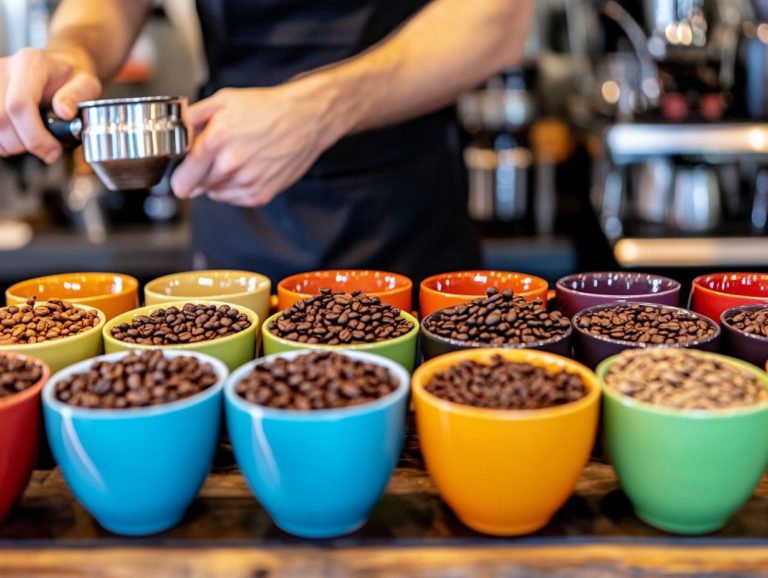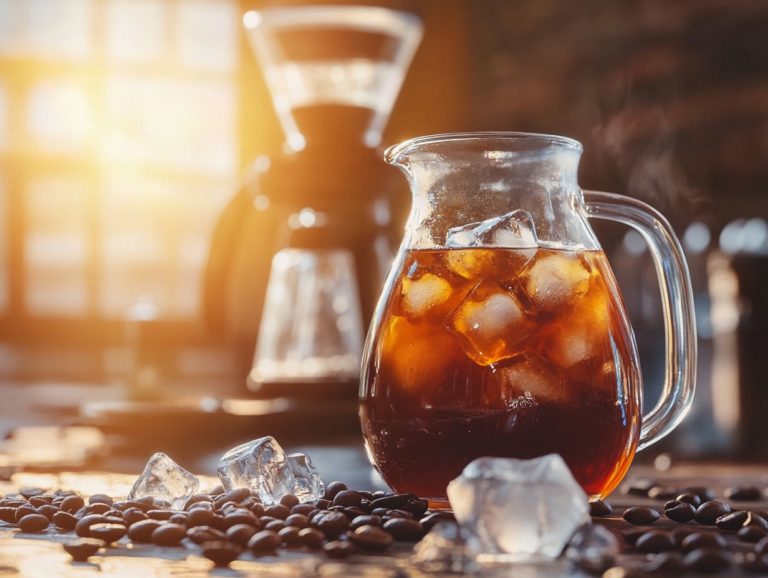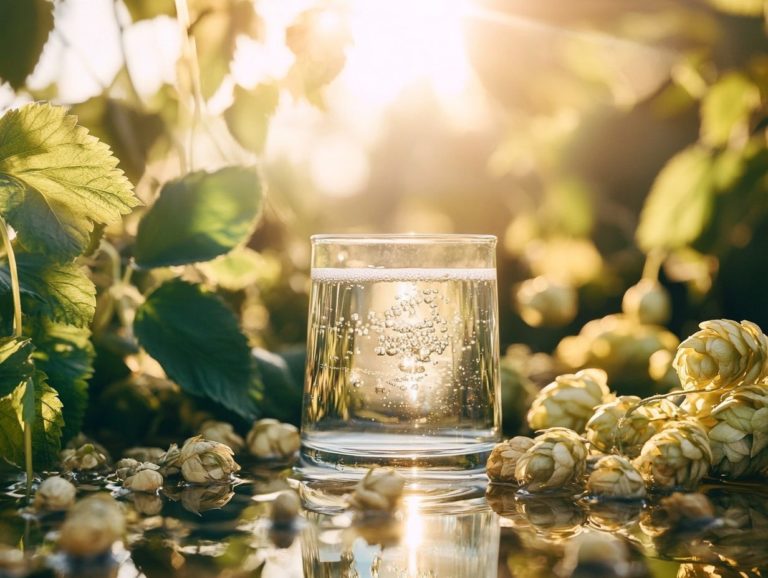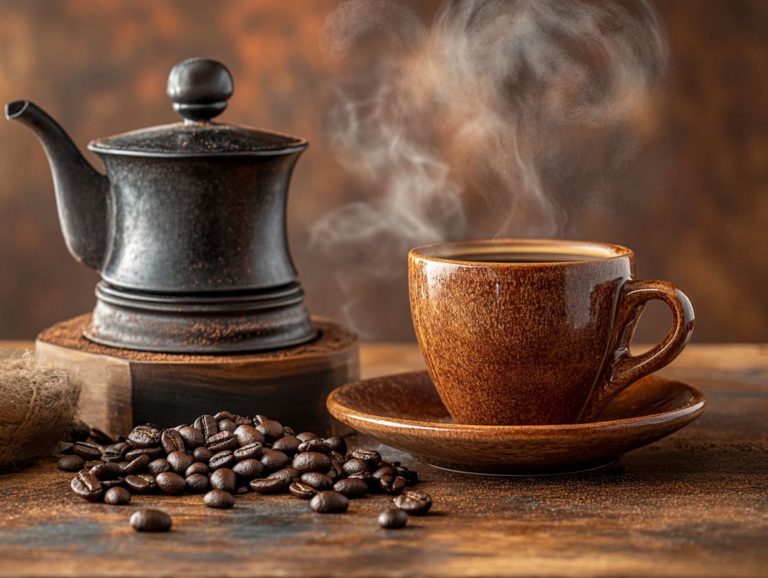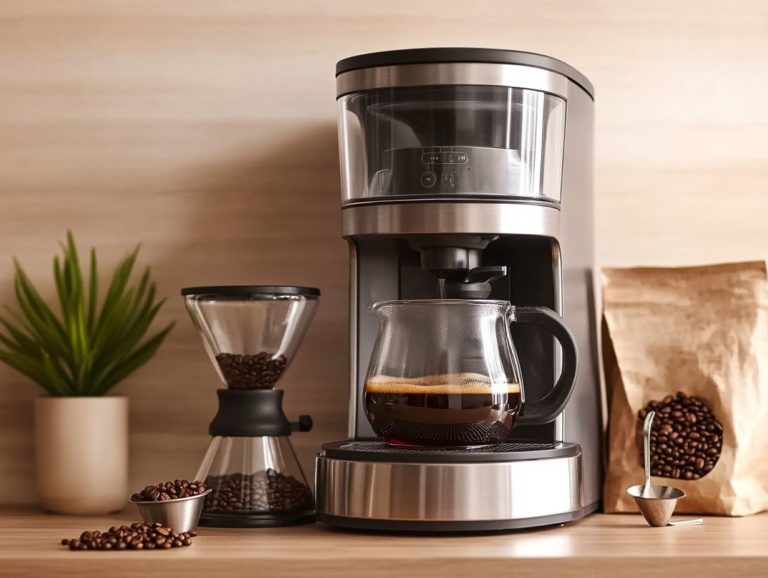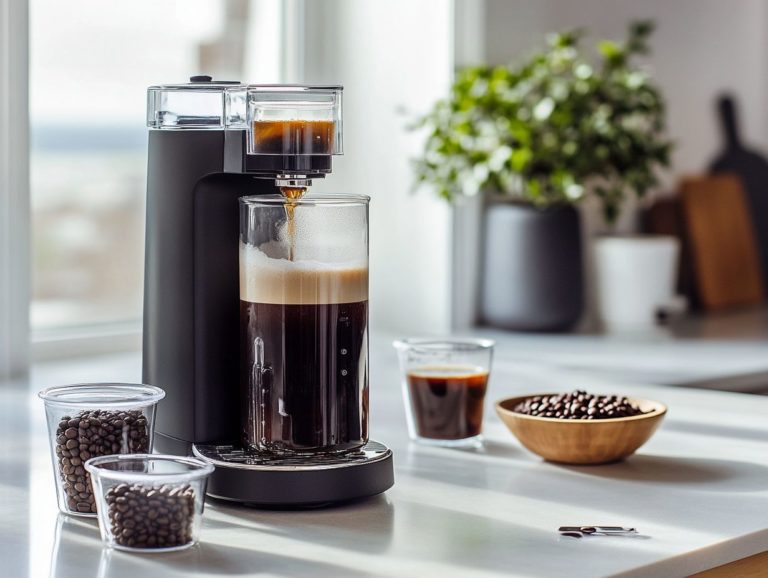How to Perfect Your Brewing Technique
Brewing the perfect cup of coffee is an art form, reliant on several key elements that each contribute significantly to the final flavor profile, much like crafting a fine beer.
Every detail counts, from the quality of the water you use to the grind size of your beans, which may remind you of the precision needed in advanced brewing techniques.
Dive into the essential components of brewing, discover various methods to experiment with, and glean tips that will refine your technique, whether you’re brewing coffee or brewing strong beers with higher alcohol content.
Whether you re just starting your journey or you re a seasoned connoisseur, nailing these key elements will undoubtedly elevate your coffee experience to extraordinary new heights, similar to the journey of a homebrewer perfecting a homebrew recipe.
Contents
- Key Takeaways:
- What Are the Basic Elements of Brewing?
- 1. Water Quality
- 2. Grind Size
- What Are the Different Brewing Methods for Coffee and Beer?
- How to Perfect Your Brewing Technique
- Perfecting Your Brewing Technique
- Frequently Asked Questions
- What are the essential steps to perfect your brewing technique?
- Why is it important to use high-quality ingredients in brewing coffee?
- How does the grind size affect the quality of the coffee?
- What is the ideal water-to-coffee ratio for brewing coffee?
- Why is temperature and time important in brewing coffee?
- Do I need expensive equipment to perfect my brewing technique?
Key Takeaways:
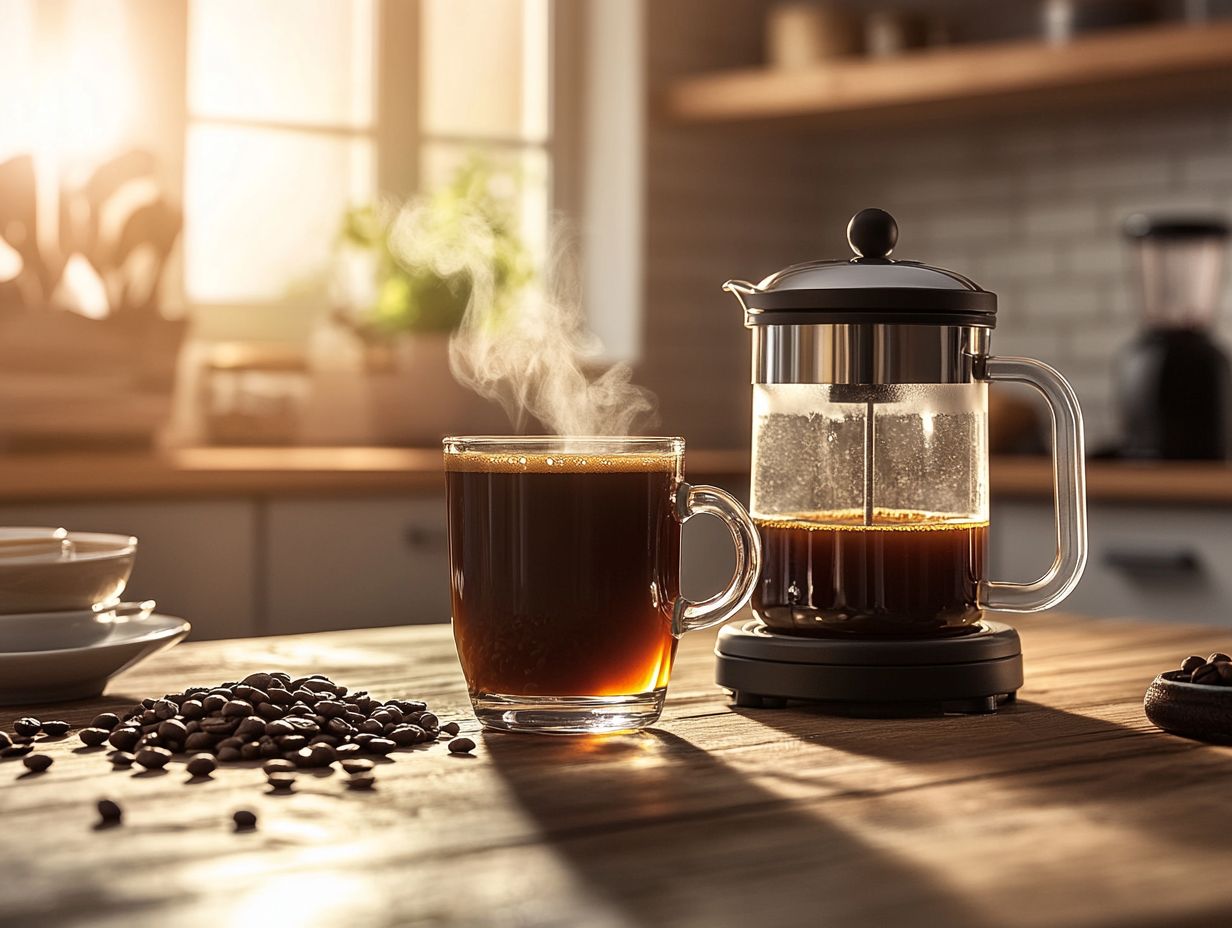
- Experiment with different ratios to find your perfect balance of coffee to water for a flavorful brew, just as you would with a beer recipe.
- Adjust your grind size to control the strength and flavor of your coffee.
- Use high-quality, freshly roasted coffee and control your water temperature for the best-tasting results.
What Are the Basic Elements of Brewing?
Brewing is a complex process, encompassing multiple fundamental elements that come together to create flavorful craft beer. At the heart of this process lie essential ingredients such as water, malt, hops, and yeast, complemented by various brewing techniques that govern the fermentation journey, including decoction mashing and dry hopping.
The quality of these components, paired with precise brewing equipment and methods, ultimately shapes the clarity, flavor profile, and overall quality of the beer you produce. Understanding these basic elements is vital for both homebrewers and commercial brewers, as they establish the foundation for achieving those desired beer styles and flavors. Utilizing tools like brewing software and brite tanks can further refine your process.
1. Water Quality
Water quality is paramount in the brewing process. It profoundly influences the flavors, clarity, and overall excellence of your beer, whether you re brewing a crisp lager or a robust stout.
The mineral content of your water including vital elements like calcium, magnesium, and sulfate can significantly affect various brewing techniques and the final character of different beer styles. For example, higher levels of calcium enhance the water’s ability to clarify your brew, while sulfate contributes to a crisp, bitter finish, which is ideal for hoppy ales. It s also essential to keep a close eye on the pH levels of your water, as they can influence enzymatic activity during mashing and ultimately affect sugar extraction.
By understanding these water qualities, you can meticulously analyze your water source and make precise adjustments such as adding salts or acids to cultivate unique flavors and achieve the desired clarity that aligns with your brewing vision, whether you re a commercial brewer or passionate about homebrewing.
2. Grind Size
The grind size of your malt is a crucial element that directly influences the mashing process and the flavors of your beer, similar to how grind size affects coffee brewing methods like French press or espresso.
When you re brewing, the efficiency of sugar extraction can vary significantly based on how coarse or fine you choose to grind the malt. A finer grind exposes more surface area, which accelerates enzyme activity and enhances sugar extraction, resulting in a fuller body and sweeter flavor in your beer.
On the flip side, a coarser grind can slow down the mashing process, potentially leading to less efficient sugar conversion. This can ultimately affect the final alcohol content and body of your brew.
Furthermore, the grind size is crucial for flavor development; finer grinds run the risk of over-extracting undesirable tannins, while coarser grinds may create a more balanced and nuanced flavor profile.
Mastering the optimal grind size is essential for you as a brewer, enabling you to refine your techniques and achieve the perfect balance in your creations. Utilizing bean-to-cup brewing equipment can also enhance the consistency and quality of your final product.
Ready to brew the perfect cup? Start experimenting today!
What Are the Different Brewing Methods for Coffee and Beer?
Exploring the diverse brewing methods opens up a fascinating world of approaches that you can employ to craft unique and flavorful beers. Each method imparts distinct characteristics to the final product. Whether you follow traditional methods or adopt more modern techniques like high-gravity brewing and barrel aging, there’s always something new to discover!
From traditional techniques like decoction mashing to contemporary methods such as dry hopping and barrel aging, the brewing landscape offers a wealth of possibilities. Each method plays a crucial role in shaping elements like flavor, aroma, and clarity. This allows you to experiment and innovate in your craft. Utilizing brite tanks for secondary fermentation can also significantly impact the final clarity and flavor of your beer.
Gaining a solid understanding of these various brewing methods is essential for anyone eager to dive deeper into the art and science of beer brewing and fermentation processes.
3. Brew Time
Brew time is a critical factor that significantly influences the brewing process. It directly impacts the extraction of flavors and the fermentation journey.
The length of the brewing process can dramatically change the final product’s characteristics. Various beer styles often demand specific timeframes to achieve their optimal flavor profiles. For example, a traditional lager typically requires a longer fermentation period. This results in a cleaner taste that highlights the malt’s richness. On the other hand, an India Pale Ale (IPA) thrives on a shorter brewing time, enhancing its aromatic qualities and hop bitterness.
The methods you choose, whether it s a cold brew or the classic kettle method, play a vital role in how flavors and aromas develop over time. By understanding these nuances, you can elevate your appreciation of the diverse spectrum of flavors that different brewing techniques can produce. This applies whether you’re a brewer or a beer enthusiast.
High-gravity brewing and barrel aging are other methods that can add complexity and depth to your creations.
4. Water Temperature
Water temperature is an essential factor in the brewing process. It significantly impacts both sugar extraction efficiency and the overall fermentation journey.
As you delve deeper into the brewing stages, you’ll find that temperature plays a pivotal role in shaping the beer s flavor profile and visual clarity. Maintaining the right temperature ranges during mashing and fermentation is crucial. This can effectively influence yeast activity and enzymatic reactions, ultimately enhancing flavor compounds and achieving a cleaner final product.
Many brewers utilize a variety of techniques, including temperature-controlled fermentation vessels, insulated mash tuns, and cutting-edge brewing technologies. These methods allow for real-time adjustments. Not only do they ensure consistency, but they also enable you to craft beers that are rich in complexity and striking in appearance.
Incorporating brewing software like BeerSmith can further enhance your precision and control.
5. Ratio of Coffee to Water
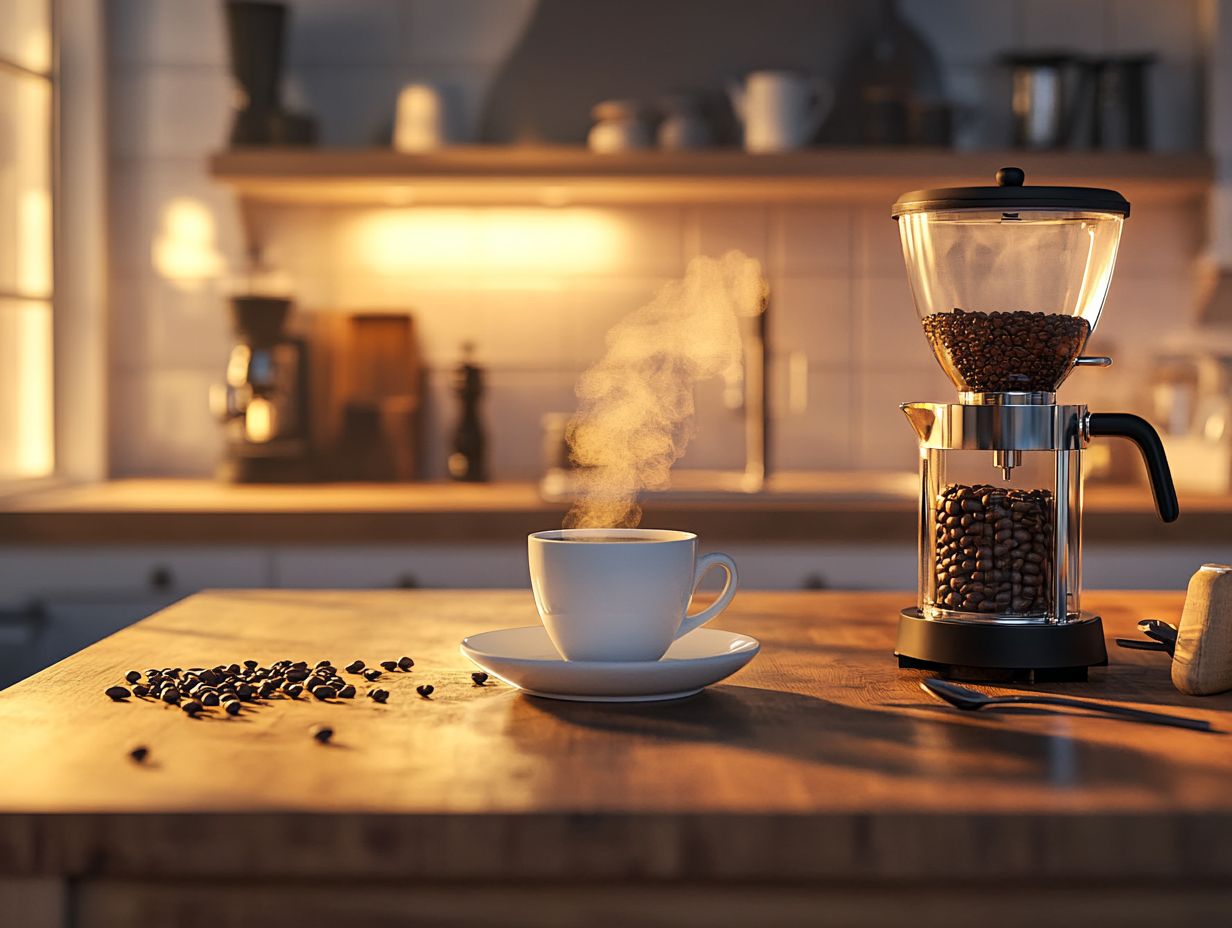
The ratio of coffee to water is a crucial element that directly affects the strength and flavor of your brew.
As you explore various brewing methods whether it’s pour-over, French press, or espresso you’ll find that precision in this ratio can dramatically transform the final taste profile. A higher coffee-to-water ratio typically yields a more robust and concentrated flavor. This allows those rich, complex notes to shine, while a lower ratio can produce a lighter, more delicate brew with brighter acidity.
For example, when using the classic pour-over technique, a 1:15 ratio often works wonders. It enables the water to extract the nuanced flavors effectively. On the other hand, when preparing espresso, a tighter range like 1:2 can extract intense flavors swiftly, resulting in a bold and luscious shot.
Ultimately, fine-tuning this ratio based on your chosen method and personal preference is key to achieving that perfect cup. Whether you are following a tried-and-true homebrew recipe or experimenting with new coffee beans from Liberty Beans Coffee, attention to detail makes all the difference!
1. Drip Coffee
Drip coffee stands as one of the most prevalent brewing methods, elegantly relying on precise water temperature and brew time to extract flavors to perfection.
The journey begins with heating water to an ideal temperature, typically between 195 and 205 degrees Fahrenheit. This crucial step encourages the dissolution of the coffee s essential oils and other remarkable compounds.
The grind size of your coffee beans is pivotal; a coarser grind permits a longer extraction time, while a finer grind increases the surface area, leading to a quicker extraction that can either enhance or mask certain flavors.
Equally important is the coffee-to-water ratio; a standard guideline recommends one to two tablespoons of coffee for every six ounces of water. You can explore variations within the drip method by adjusting brewing time or experimenting with different roasts. Doing so can dramatically influence the final taste profile, much like experimenting with different hop varieties in beer brewing.
Experimenting with different techniques can lead you to a cup of coffee that surprises your palate. You might enjoy a cup that ranges from bright and fruity to rich and full-bodied, allowing you to tailor your coffee experience to your unique preferences. Similarly, understanding the fermentation process and yeast pitching can help tailor the complexity and depth of your beer.
2. French Press and Hop Varieties
The French press is a beloved brewing method that captivates with its full-bodied flavor and rich aroma, achieved through meticulous attention to brew time and grind size adjustments.
You’ll quickly discover that steeping time is crucial, typically lasting between four and five minutes. This period allows the coffee grounds to fully infuse their flavors into the water.
By following a coffee-to-water ratio of approximately one to fifteen, you can tailor the brew strength to perfectly match your personal taste preferences. Much like the Beer Judge Certification Program (BJCP) helps refine beer judging, understanding these parameters can refine your coffee brewing skills.
Making adjustments to the grind size whether you prefer it coarse or medium can significantly influence extraction and filtration, ultimately affecting the smoothness and depth of your final brew. Each variation presents a unique flavor profile, inviting you to explore a delightful spectrum of tastes, from earthy undertones to vibrant fruity notes.
Consider how these adjustments parallel the precision needed in beer brewing. Understanding these elements can lead to an exceptional cup every time.
3. Pour Over
Pour over is a meticulous brewing method that offers you precise control over water temperature and brew time, resulting in a clean, flavorful cup that speaks to your discerning palate.
This method echoes the precision found in brewing beer, where attention to detail is paramount. Each step from the grind size of your coffee to the rate at which you pour the water plays a crucial role in shaping the final flavor profile.
As you embrace the pour-over method, you’ll find yourself attuned to details like the bloom phase, where hot water pre-wets the coffee grounds, awakening the essential oils and gases that contribute to a richer taste experience.
By adjusting brewing parameters such as water chemistry, grind size, and pouring technique, you can greatly influence the extraction process. This can culminate in a cup that might be bright and floral or indulgently rich and chocolatey.
Thus, mastering the pour-over is not just about consistency; it s about understanding how each variable intertwines to create that perfect sip tailored to your preferences.
4. AeroPress
The AeroPress is an incredibly versatile brewing method that seamlessly combines immersion and pressure. This allows you to extract rich flavors from coffee grounds in no time. This method can be compared to the versatility found in brewing techniques for craft beer.
With this innovative device, you have the freedom to adjust brewing times and coffee-to-water ratios. This enables you to create a cup that perfectly suits your individual taste preferences. Unlike traditional methods like drip or French press, the AeroPress invites a delightful mix of convenience and experimentation that coffee lovers truly savor. Such experimental spirit can also be seen in dry hopping and barrel aging in beer brewing.
Its ability to produce a clean and flavorful brew, with a clarity of taste that stands out, sets it apart from other techniques. You can explore a range of profiles from robust espresso-style shots to elegant, lighter brews. This makes the AeroPress an exhilarating choice for both casual drinkers and seasoned baristas alike.
5. Cold Brew
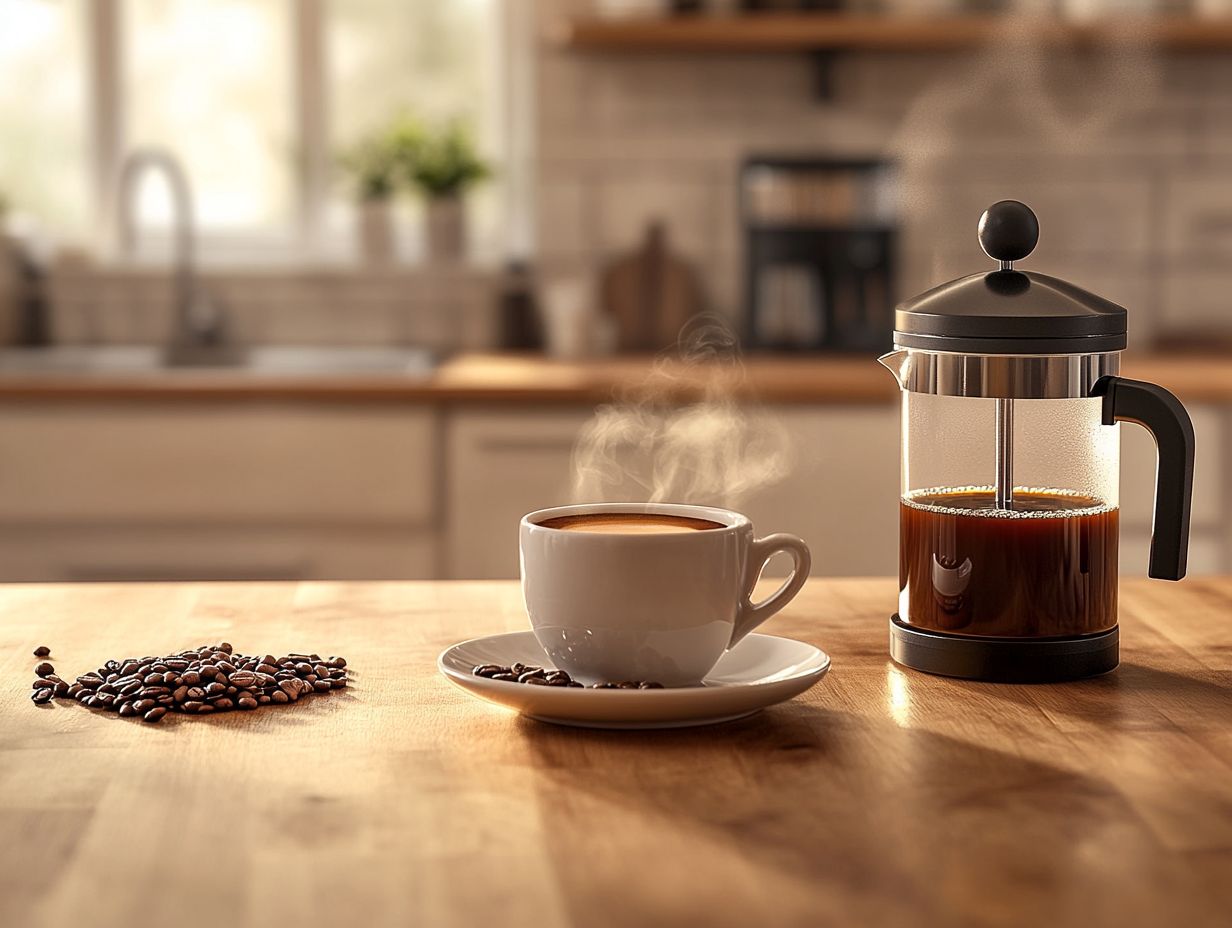
Cold brew is a refreshing brewing method that stands out due to its extended brew time. This allows for a smooth, less acidic coffee extraction. This technique involves steeping coarsely ground coffee in cold or room temperature water for an impressive duration, typically between 12 to 24 hours. This extended process can be paralleled with strategies in high-gravity brewing for creating robust beers.
For the perfect cold brew, a recommended coffee-to-water ratio is 1:4 or 1:5. This strikes a balance that delivers a concentrated flavor without overwhelming your taste buds. The end result is a rich, naturally sweet brew boasting pronounced chocolate and nutty notes that set it apart from traditional hot coffee.
As a coffee enthusiast, you can also experiment with various flavor additions. Try adding vanilla, caramel, or seasonal spices. This way, each cup can become a unique experience tailored to your diverse palate. Experimenting with different hop varieties in beer brewing yields many distinctive flavors.
How to Perfect Your Brewing Technique
Perfecting your brewing technique is crucial for unlocking the full potential of beer flavors and ensuring successful fermentation processes. This applies whether you re a seasoned homebrewer or just starting your journey. From decoction mashing a brewing method where you boil part of the mash to improve flavor to using brite tanks for clarity, every detail matters.
This journey involves experimenting with various brewing methods and fine-tuning key parameters like grind size, brew time, and water temperature. Use high-quality ingredients throughout the process. Utilizing brewing software like BeerSmith can help manage these variables efficiently.
By refining these techniques, you can craft personalized homebrew recipes that showcase different beer styles and flavors. This makes each batch not just a drink, but a true testament to your craftsmanship. Drawing inspiration from experts like Ben Stange and Dr. Brad Smith can provide valuable insights into the world of homebrewing.
1. Experiment with Different Ratios
Experimenting with different brew ratios is essential for you as a brewer. This helps elevate your beer’s flavors and optimize the fermentation process. This is particularly important in decoction mashing and other traditional brewing methods.
By adjusting the amounts of grains, hops, and water, you can significantly transform the taste and aroma of your beer. For example, increasing the malt proportion in an all-grain brewing method might amplify the sweetness and body. This ultimately results in a rich, full-bodied stout. On the other hand, when crafting a hop-forward style like a pale ale, achieving the perfect balance of hops during the boil can create a delightful bitterness and enhance the floral aroma. Using brewing equipment like brite tanks can further improve the clarity and quality of your beer.
The same principle applies to cold brew coffee. By varying the coffee-to-water ratio, you can achieve a smoother, less acidic brew. This demonstrates that even slight adjustments in ratios enhance flavor profiles and dramatically influence the overall quality of your final product. Similarly, adapting yeast pitching rates in beer brewing can significantly affect the outcome.
2. Adjust Your Grind Size
Adjusting your grind size is essential for optimizing your brewing techniques. It helps you achieve the desired clarity in your final beer product. This is akin to fine-tuning the mashing process to enhance beer clarity.
The grind size significantly influences how well flavors are drawn out, impacting not just the flavor profile of your beer but also its overall aroma and mouthfeel. For instance, a finer grind increases surface area for quicker extraction, which is ideal for brewing methods like espresso and cold brew. A coarser grind allows for slower extraction, perfect for techniques such as French press and pour-over. In beer brewing, adjusting the grind size also affects the efficiency of the brewing process.
Don t hesitate to experiment based on your chosen brewing method! Start with a medium grind for drip coffee and adjust the coarseness according to steeping times. Remember, even small adjustments can reveal hidden flavor nuances that elevate your entire brewing experience. This approach is similar to tweaking variables in brewing methods to discover the best beer styles.
3. Control Your Water Temperature
Control water temperature during brewing to achieve effective extraction and successful fermentation. In both coffee and beer brewing, temperature control is vital for optimal flavor development.
The water temperature profoundly influences every stage of brewing, shaping the flavors and aromas of your final product. For example, maintaining a steady temperature around 152 F during mashing allows enzymes to efficiently convert starches into sugars, maximizing your extract.
Keep the temperature in the ideal range for your specific yeast strain, typically between 65 F and 75 F. This encourages healthy yeast activity and wards off any undesirable flavors.
To attain optimal temperatures, use insulated vessels, thermometer probes, or even temperature-controlled environments. By watching for temperature fluctuations and making necessary adjustments, you can unlock the full potential of your brewing craft. This applies whether you’re perfecting a coffee brew or refining a homebrew recipe!
4. Try Different Brewing Methods
Exploring different brewing methods is crucial for any brewer eager to broaden their expertise and craft unique beer styles. Investigate techniques like all-grain brewing, mash hopping, or experimenting with various fermentation temperatures. These efforts can unlock a remarkable range of flavors and characteristics in your homebrews.
Each method brings unique qualities, transforming a standard pale ale into a hoppy masterpiece or elevating a simple stout into a complex, rich experience. Stepping outside your comfort zone sharpens your brewing skills and nurtures creativity, leading to delightful surprises in every batch you create.
Start your brewing adventure today, and discover the flavors waiting for you!
Perfecting Your Brewing Technique
5. Use High-Quality, Freshly Roasted Coffee
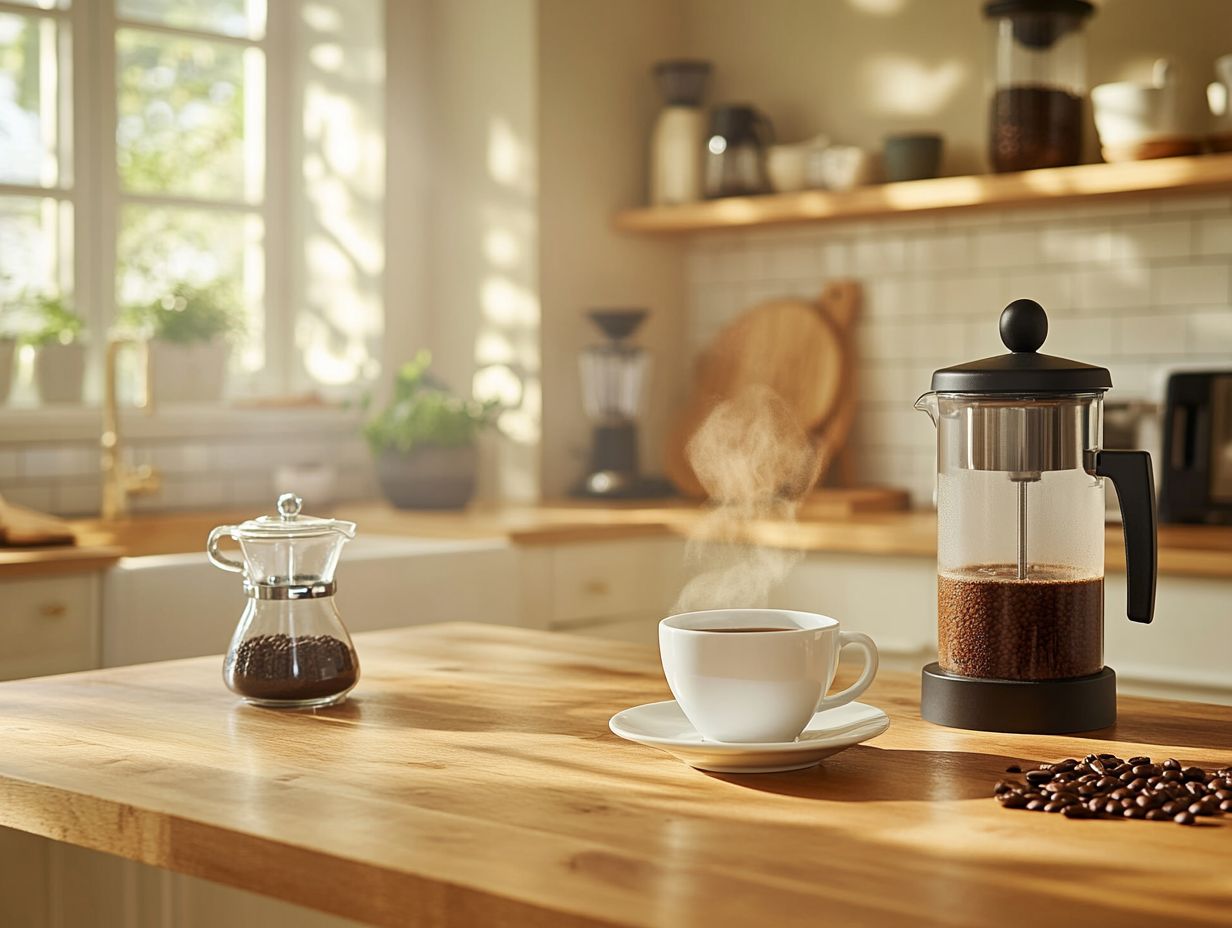
Using high-quality, freshly roasted coffee can greatly elevate your brewing experience and enhance the flavors of your final cup.
The selection of beans is essential in shaping the depth and complexity of flavors you ll savor in each sip. When choosing coffee, prioritize beans that are ethically sourced and sustainably grown. This often signals a commitment to superior quality.
This principle of getting high-quality ingredients applies equally to selecting grains, hops, and yeast in beer brewing.
Monitor the roast date, as beans are at their peak within a few weeks of roasting. Don’t hesitate to explore different regions and processing methods to uncover the unique profiles that resonate with your taste buds. This attention to freshness is just as important in beer brewing, where the quality of hops and malt can make a significant difference.
Opting to purchase from local roasters or reputable online sources ensures you re getting the freshest beans available. Remember, the journey to brewing the perfect cup begins with quality ingredients. Investing in them rewards you with an exceptional experience in every sip.
For those into beer brewing, consider sourcing ingredients from trusted suppliers such as Liberty Beans Coffee for unique flavor profiles.
Frequently Asked Questions
What are the essential steps to perfect your brewing technique?
Perfecting your brewing technique is essential in both coffee and beer brewing. Here are some steps to guide you:
To perfect your brewing technique, you need to follow these essential steps:
1. Choose high-quality ingredients
2. Measure and grind your coffee beans properly
3. Use the right water-to-coffee ratio
4. Brew at the right temperature and time
5. Experiment with different brewing methods
6. Practice and refine your technique
Why is it important to use high-quality ingredients in brewing coffee?
High-quality ingredients are crucial for the best results, whether you’re brewing coffee or beer. Freshly roasted coffee beans will have a direct impact on the taste and flavor of your coffee.
Stale or low-quality ingredients can ruin your chance of a perfect cup!
How does the grind size affect the quality of the coffee?
The grind size is crucial in brewing coffee because it determines the surface area of the coffee beans that will be exposed to water. A finer grind will result in a stronger and more flavorful cup, while a coarser grind will produce a weaker and less intense brew.
What is the ideal water-to-coffee ratio for brewing coffee?
The ideal water-to-coffee ratio is subjective and can vary depending on personal preference. However, a good starting point is to use 1-2 tablespoons of ground coffee per 6 ounces of water. Adjust the ratio to your taste by experimenting with different measurements.
Why is temperature and time important in brewing coffee?
The temperature and time of the brewing process affect the extraction of flavors from the coffee beans. Water that is too hot or too cold can result in a bitter or weak brew.
Similarly, brewing for too long or too little can also affect the taste and strength of the coffee.
Do I need expensive equipment to perfect my brewing technique?
No, you do not need expensive equipment to brew a great cup of coffee. While high-quality equipment can enhance your brewing experience, you can achieve excellent results with basic tools such as a French press or pour-over cone.
What matters most is using the correct techniques and high-quality ingredients.
Start experimenting with fresh beans and brewing techniques today for the best cup of coffee you ve ever had!

